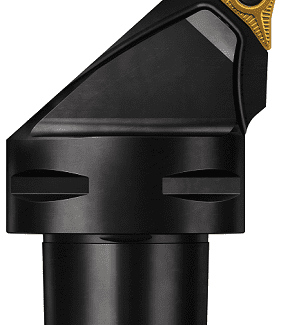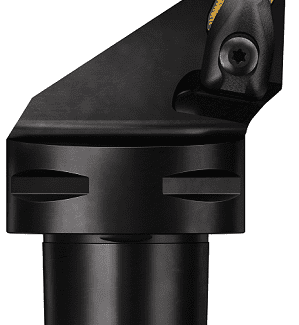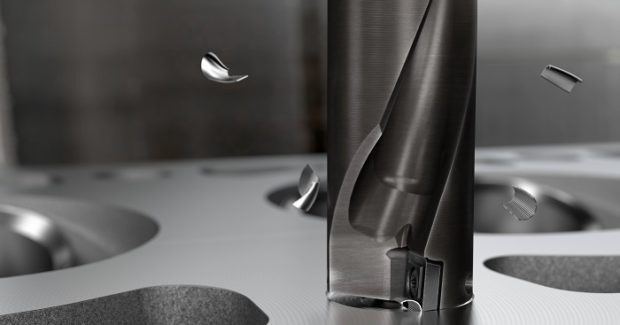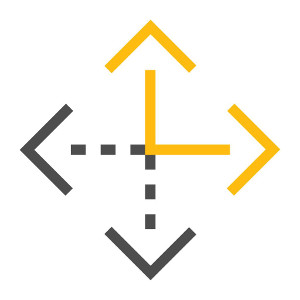Drilling and Boring Aluminum Components with Dazzling Performance
CoroDrill 880 CVD diamond-coated insert grades GCN124 and GCN134 from Sandvik Coromant have super-hard properties that provide long tool life and combine with innovative chip breaker and geometry designs to guarantee superior performance when drilling materials such as aluminum.
Posted: December 19, 2017
In order to overcome the challenges of chip formation and evacuation when drilling non-ferrous metals, Sandvik Coromant Inc. (Fair Lawn, NJ) has unveiled their CoroDrill® 880 CVD diamond-coated insert grades, GCN124 and GCN134, with super-hard properties that provide long tool life and combine with innovative chip breaker and geometry designs to guarantee superior performance when drilling materials such as aluminum. These are ideal for automotive manufacturers that drill and bore aluminum components, such as cylinder blocks, cylinder heads, knuckles, housings, brake calipers, control arms, transmission cases, steering-column covers, and yokes.
“Making holes in aluminum can be a challenging task,” explains Patrik Pichler, the global product manager of indexable drilling tools at Sandvik Coromant. “Ductility and softness cause the material to make constant and prolonged contact with the insert’s cutting edges. As a consequence, the aluminum adheres to the cutting edge and creates a built-up edge (BUE) that makes chip formation and evacuation difficult.” GCN124 and GCN134 diamond-coated insert grades offer the lowest cost per hole in most ISO N materials through long lasting insert tool life and/or greater productivity. The increased productivity can be gained from elevated cutting data, as well as a result of less machine downtime thanks to fewer insert changes. Further advantages available to users include easier handling in production through the reliability and longer life of the inserts, as well as enhanced surface finish inside the hole resulting from the ability to resist BUE and smearing effects. Reduced insert consumption also helps lower stock levels and environmental impact.
To highlight the potential of these new grades, when drilling a 22 mm diameter blind hole to a depth of 84.1 mm in a cylinder head made from 6061-T6 aluminum (90-100 HB), CoroDrill 880 mounted with the new N124 (peripheral) and N134 (central) inserts extended tool life from 700 pieces to 3,024 pieces, an impressive 332 percent increase. The new insert permitted increased cutting speed, allowing productivity to increase by 33 percent. Some 300 total hours of production time were saved while overall cost per hole was reduced by 23 percent. Similar success was achieved when performing through-hole drilling (22.5 mm diameter) in 20 mm thick automotive front control arms made from AISi1Mg-T6 aluminum (150 HB). Here, the CoroDrill 880 diamond-coated inserts helped elevate tool life from 3,000 pieces to 30,000 pieces. Productivity also improved by 10 percent due to less machine downtime for insert indexing, while cost per hole was reduced by 17 percent.
GCN124 and GCN134 are now the First Choice insert grades for ISO N materials. They complement the existing H13A uncoated insert that remains the recommended insert in applications involving shorter production runs and/or difficult interrupted cuts. The standard CoroDrill 880 range features indexable insert drills from 12 mm to 84 mm (0.472 in to 3.307 in) diameter, with drill lengths of 2xD, 3xD, 4xD, and 5xD. With Sandvik Coromant’s Tailor Made offer, users can order intermediate diameter and length combinations as well as different connection types and sizes such as HSK, Coromant Capto®, or cylindrical shank. One of the Tailor Made options includes the ability to design customized step and chamfer drills for specific components.
Sandvik Coromant also offers a revolutionary new turning concept for improved machining flexibility and potentially significant productivity gains in automotive applications: PrimeTurning™ is the first true ‘all-directional turning’ methodology. Unlike conventional turning operations that have remained largely unchanged for decades, PrimeTurning allows machine shops to complete longitudinal (forward and back), facing, and profiling operations with a single tool. This methodology is based on the tool entering the component at the chuck and removing material as it travels towards the end of the component. This allows for the application of a small entering angle, higher lead angle, and the possibility of machining with higher cutting parameters. Furthermore, conventional turning (from part-end to chuck) can be performed using the same tools.
Some applications could see potential productivity increases in excess of 50 percent through the deployment of PrimeTurning rather than conventional techniques. Some of these improvements are a result of the small entering angle and higher lead angle, which creates thinner, wider chips that spread the load and heat away from the nose radius. The result is both increased cutting data and extended tool life. In addition, as cutting is performed in the direction moving away from the shoulder, there is no danger of chip jamming (a common and unwanted effect of conventional longitudinal turning). Higher machine utilization as a result of reduced setup time and fewer production stops for tool changes also enhances overall productivity. PrimeTurning is particularly beneficial in automotive work where there is a need to perform external turning operations in large batch productions or where multiple setups and tool changes are often required.
“Experienced operators know that a small entering angle allows for increased feed rates,” notes Håkan Ericksson, a global product specialist at Sandvik Coromant. “But in conventional turning, they are restricted to using entering angles of around 90 deg to reach the shoulder and avoid the long, curved chips that a small entering angle characteristically delivers. PrimeTurning solves these problems by combining a perfect reach at the shoulder and the application of 25 deg to 30 deg entering angles with excellent chip control and maintained tolerances. This innovation presents countless possibilities to perform turning operations in much more efficient and productive ways. It’s not just a new tool, it’s a totally new way of turning.”
This methodology is initially supported by the introduction of two dedicated CoroTurn® Prime turning tools and the PrimeTurning code generator that supplies optimized programming codes and techniques and not only ensures maximum output, but also process security with suitably adjusted feed rate and entry radius parameters. It creates ISO codes that are compatible with various CNC systems.
CoroTurn Prime inserts have three edges/corners: one for longitudinal turning, one for facing, and one for profiling to deliver efficient edge utilization and longer tool life. Two unique and dedicated inserts are offered: CoroTurn Prime A-type has three 35 deg corners for light roughing, finishing and profiling, while CoroTurn Prime B-type has ultra-strong corners specifically for rough machining. Suitable for ISO P (steel), S (heat-resistant super alloys and titanium), and M (stainless steel) category materials, nine CoroTurn Prime A-type and six CoroTurn Prime B-type inserts are currently available, with expansion to other materials planned for the future. The inserts are supported by 52 variants of tool holders, including Coromant Capto®, CoroTurn QS, and shanks.
Sandvik Coromant Inc., 1702 Nevins Road, Fair Lawn, NJ 07410-0428, 201-794-5000, Fax: 1-201-794-5157, www.sandvik.coromant.com.








